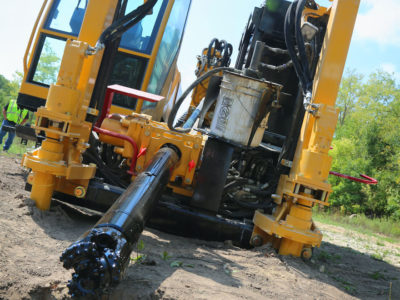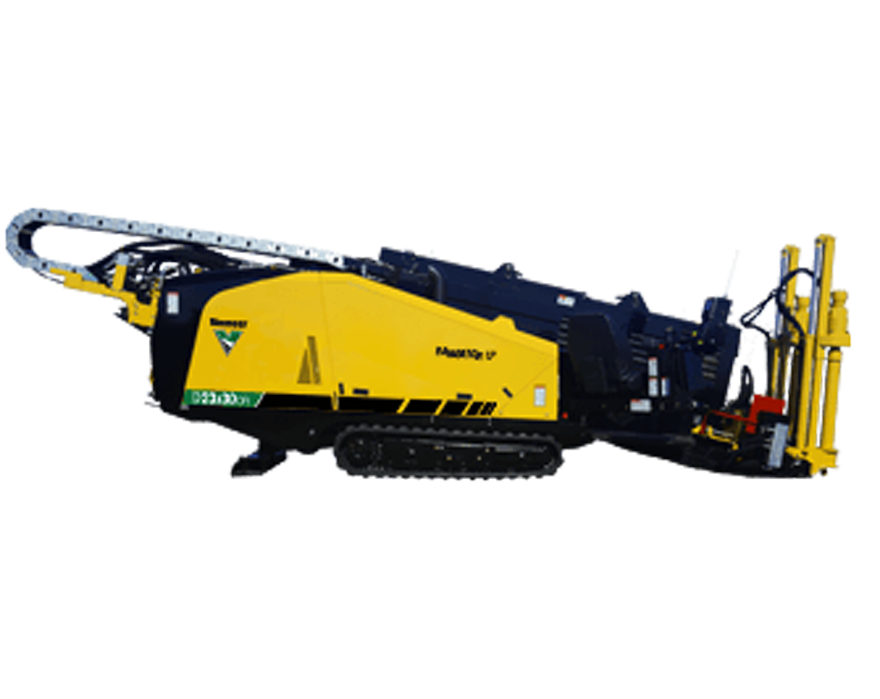Dual-rod horizontal directional drills (HDDs) like the Vermeer D40x55DR S3 and D23x30DR S3 Navigator® HDDs represent the latest technology for drilling rock. But as with any technology, many HDD contractors may be wondering: Is a dual-rod machine a better option than a single-rod machine?
As you are researching options for boring rock as efficiently as possible, Tod Michael, product manager for trenchless core products, offers the following advice: HDD utility contractors who perform 50% or more of their bores in soft- to medium-density rock, up to 24,000 psi (165.5 MPa) compressive strength, should absolutely consider investing in a dual-rod HDD. For contractors boring in rock less than 25% of the time, there is probably a more economical single-rod tooling setup to meet their needs.
And for anyone whose rock-boring work falls between those two ranges, other factors should be considered before deciding if they will benefit from adding a dual-rod machine.
First things first
Before diving into whether or not you should invest in a dual-rod machine, you need to know a little bit about the technology and its advantages for drilling in rock. “Dual-rod systems use two independently controlled drill rods — one within the other — during operation,” explained Michael. “While drilling out the pilot bore, the outer rod provides rotation for steering, while the inner rod supplies torque to a tri-cone or PDC drill bit. It’s a powerful combination that delivers optimal downhole cutting action and steerability. Its footprint is similar to its single-rod corresponding model, making it a more compact option than other rock drilling solutions.”
Rock density
One of the first factors to consider before choosing a dual-rod machine is the type of rock you’re working in. “Dual-rod drills are efficient in light- and medium-density rocks,” explained Michael. “If consistently above 20,000 psi (137.9 MPa) compressive strength, a contractor may want to consider using a utility drill with an air hammer or a mud motor. While dual-rod machines are capable of drilling in hard rock, production can be better with one of those two options.”
Jobsite
For most utility HDD work, small jobsites and the ability to quickly set up and tear down are essential to a crew’s operating efficiency. “Dual-rod machines can often be transported on the same trailer as their similar single-rod counterpart, are convenient to set up and don’t require any additional space,” explained Michael.
So, if your crews typically perform several drill shots a day or throughout the week, a dual-rod machine has several advantages over other rock drilling tech. However, a single-rod machine and an air hammer or rock-bit system like the Vermeer Armor drilling system may be a more economical option if you’re not performing rock bores frequently.
“Contractors need to look at their operating costs to determine which is the best option for their needs,” said Michael. “The crew may be able to get a project done faster with a dual-rod machine, but it may be more economical in the long run to take a little longer and use a single-rod drill with other rock drilling technology.”
Operator
Of course, how long a bore takes can often depend on the operator’s skills running the drill. Michael said the operator’s capabilities on the drill is another critical factor to consider when deciding between a single-rod and a dual-rod machine. “Running an air hammer takes a more training and talent,” he explained. “In solid rock, they have to get the drill path right the first time because it can be a real challenge to back up and adjust. Also, if the ground conditions change from rock to clay or sand, operators may either need to trip out and change their tooling, or they need to understand how to work their way through the changing conditions. It can be challenging.”
Michael went on to say that most good operators on a single-rod machine should be able to become efficient at operating a dual-rod machine. “There aren’t any extra steps with the dual-rod drill. There is an extra connection, but the machine handles that on its own. Operators need to understand the finer points of drilling in rock, but if they have those, stepping up to a rock drill should be a fairly smooth transition.”
Operational costs
As you can see, the decision to add a dual-rod machine if more than 50% of your work is in rock, or to add a single-rod machine if less than 25% of your work is in rock, is pretty straightforward. However, if you fall someplace in the middle, then you have a lot to consider. Think about what will be the most efficient drill throughout its service life.
Dual-rod machines work in rock, clay, sand and loamy soils. Still, that versatility comes at higher upfront investment, which is why it’s not right for every contractor. With single-rod machines, you can use a rock bit or an air hammer, but over the long run, it may or may not be more cost efficient than the dual rod.
“Every contractor’s situation is different, which is why it’s not always an easy decision,” said Michael. “If a contractor isn’t sure which solution is right for their needs, they should talk to their local Vermeer dealer. They can tell them what other contractors in the area are using and even help them estimate costs to help them make a more informed decision.”
If you have questions about whether your next drill should be a single-rod or dual-rod unit, contact your local Vermeer dealer. You can also learn more about the entire Vermeer utility HDD product lineup.
Vermeer Corporation reserves the right to make changes in engineering, design and specifications; add improvements; or discontinue manufacturing at any time without notice or obligation.
Equipment shown is for illustrative purposes only and may display optional accessories or components specific to their global region. Please contact your local Vermeer dealer for more information on machine specifications. Vermeer, the Vermeer logo and Navigator are trademarks of Vermeer Manufacturing Company in the U.S. and/or other countries.

